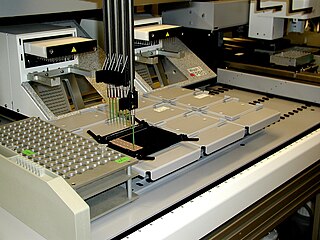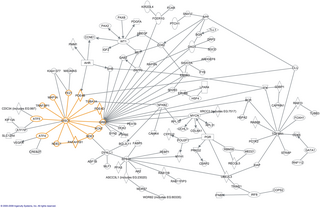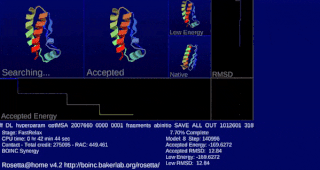Related Research Articles

Bioinformatics is an interdisciplinary field of science that develops methods and software tools for understanding biological data, especially when the data sets are large and complex. Bioinformatics uses biology, chemistry, physics, computer science, computer programming, information engineering, mathematics and statistics to analyze and interpret biological data. The subsequent process of analyzing and interpreting data is referred to as computational biology.

The proteome is the entire set of proteins that is, or can be, expressed by a genome, cell, tissue, or organism at a certain time. It is the set of expressed proteins in a given type of cell or organism, at a given time, under defined conditions. Proteomics is the study of the proteome.

Proteomics is the large-scale study of proteins. Proteins are vital parts of living organisms, with many functions such as the formation of structural fibers of muscle tissue, enzymatic digestion of food, or synthesis and replication of DNA. In addition, other kinds of proteins include antibodies that protect an organism from infection, and hormones that send important signals throughout the body.

Computational biology refers to the use of data analysis, mathematical modeling and computational simulations to understand biological systems and relationships. An intersection of computer science, biology, and big data, the field also has foundations in applied mathematics, chemistry, and genetics. It differs from biological computing, a subfield of computer engineering which uses bioengineering to build computers.

Structural genomics seeks to describe the 3-dimensional structure of every protein encoded by a given genome. This genome-based approach allows for a high-throughput method of structure determination by a combination of experimental and modeling approaches. The principal difference between structural genomics and traditional structural prediction is that structural genomics attempts to determine the structure of every protein encoded by the genome, rather than focusing on one particular protein. With full-genome sequences available, structure prediction can be done more quickly through a combination of experimental and modeling approaches, especially because the availability of large number of sequenced genomes and previously solved protein structures allows scientists to model protein structure on the structures of previously solved homologs.

Protein structure prediction is the inference of the three-dimensional structure of a protein from its amino acid sequence—that is, the prediction of its secondary and tertiary structure from primary structure. Structure prediction is different from the inverse problem of protein design. Protein structure prediction is one of the most important goals pursued by computational biology; and it is important in medicine and biotechnology.
In computational biology, gene prediction or gene finding refers to the process of identifying the regions of genomic DNA that encode genes. This includes protein-coding genes as well as RNA genes, but may also include prediction of other functional elements such as regulatory regions. Gene finding is one of the first and most important steps in understanding the genome of a species once it has been sequenced.

In molecular biology, an interactome is the whole set of molecular interactions in a particular cell. The term specifically refers to physical interactions among molecules but can also describe sets of indirect interactions among genes.

World Community Grid (WCG) is an effort to create the world's largest volunteer computing platform to tackle scientific research that benefits humanity. Launched on November 16, 2004, with proprietary Grid MP client from United Devices and adding support for Berkeley Open Infrastructure for Network Computing (BOINC) in 2005, World Community Grid eventually discontinued the Grid MP client and consolidated on the BOINC platform in 2008. In September 2021, it was announced that IBM transferred ownership to the Krembil Research Institute of University Health Network in Toronto, Ontario.
Modelling biological systems is a significant task of systems biology and mathematical biology. Computational systems biology aims to develop and use efficient algorithms, data structures, visualization and communication tools with the goal of computer modelling of biological systems. It involves the use of computer simulations of biological systems, including cellular subsystems, to both analyze and visualize the complex connections of these cellular processes.

The Human Proteome Folding Project (HPF) is a collaborative effort between New York University, the Institute for Systems Biology (ISB) and the University of Washington, using the Rosetta software developed by the Rosetta Commons.

Protein–protein interactions (PPIs) are physical contacts of high specificity established between two or more protein molecules as a result of biochemical events steered by interactions that include electrostatic forces, hydrogen bonding and the hydrophobic effect. Many are physical contacts with molecular associations between chains that occur in a cell or in a living organism in a specific biomolecular context.
Protein subcellular localization prediction involves the prediction of where a protein resides in a cell, its subcellular localization.

Rosetta@home is a volunteer computing project researching protein structure prediction on the Berkeley Open Infrastructure for Network Computing (BOINC) platform, run by the Baker laboratory at the University of Washington. Rosetta@home aims to predict protein–protein docking and design new proteins with the help of about fifty-five thousand active volunteered computers processing at over 487,946 GigaFLOPS on average as of September 19, 2020. Foldit, a Rosetta@home videogame, aims to reach these goals with a crowdsourcing approach. Though much of the project is oriented toward basic research to improve the accuracy and robustness of proteomics methods, Rosetta@home also does applied research on malaria, Alzheimer's disease, and other pathologies.

David Baker is an American biochemist and computational biologist who has pioneered methods to predict and design the three-dimensional structures of proteins. He is the Henrietta and Aubrey Davis Endowed Professor in Biochemistry and an adjunct professor of genome sciences, bioengineering, chemical engineering, computer science, and physics at the University of Washington. He serves as the director of the Rosetta Commons, a consortium of labs and researchers that develop biomolecular structure prediction and design software. The problem of protein structure prediction to which Baker has contributed significantly has now been largely solved by DeepMind using artificial intelligence. Baker is a Howard Hughes Medical Institute investigator and a member of the United States National Academy of Sciences. He is also the director of the University of Washington's Institute for Protein Design.
In computational biology, de novo protein structure prediction refers to an algorithmic process by which protein tertiary structure is predicted from its amino acid primary sequence. The problem itself has occupied leading scientists for decades while still remaining unsolved. According to Science, the problem remains one of the top 125 outstanding issues in modern science. At present, some of the most successful methods have a reasonable probability of predicting the folds of small, single-domain proteins within 1.5 angstroms over the entire structure.
Biology data visualization is a branch of bioinformatics concerned with the application of computer graphics, scientific visualization, and information visualization to different areas of the life sciences. This includes visualization of sequences, genomes, alignments, phylogenies, macromolecular structures, systems biology, microscopy, and magnetic resonance imaging data. Software tools used for visualizing biological data range from simple, standalone programs to complex, integrated systems.

Ram Samudrala is a professor of computational biology and bioinformatics at the University at Buffalo, United States. He researches protein folding, structure, function, interaction, design, and evolution.
The human interactome is the set of protein–protein interactions that occur in human cells. The sequencing of reference genomes, in particular the Human Genome Project, has revolutionized human genetics, molecular biology, and clinical medicine. Genome-wide association study results have led to the association of genes with most Mendelian disorders, and over 140 000 germline mutations have been associated with at least one genetic disease. However, it became apparent that inherent to these studies is an emphasis on clinical outcome rather than a comprehensive understanding of human disease; indeed to date the most significant contributions of GWAS have been restricted to the “low-hanging fruit” of direct single mutation disorders, prompting a systems biology approach to genomic analysis. The connection between genotype and phenotype remain elusive, especially in the context of multigenic complex traits and cancer. To assign functional context to genotypic changes, much of recent research efforts have been devoted to the mapping of the networks formed by interactions of cellular and genetic components in humans, as well as how these networks are altered by genetic and somatic disease.

AlphaFold is an artificial intelligence (AI) program developed by DeepMind, a subsidiary of Alphabet, which performs predictions of protein structure. The program is designed as a deep learning system.
References
- ↑ Renfrew PD, Campbell G, Strauss CEM, Bonneau R (2011) The 2010 Rosetta Developers Meeting: Macromolecular Prediction and Design Meets Reproducible Publishing. PLoS ONE 6(8): e22431
- ↑ Renfrew PD, Choi EJ, Bonneau R, Kuhlman B (2012) Incorporation of Noncanonical AminoAcids into Rosetta and Use in Computational Protein-Peptide Interface Design.PLoS ONE 7(3): e32637.
- ↑ Drew K, Winters P, Butterfoss GL, Berstis V, Uplinger K, Armstrong J, Riffle M, Schweighofer E, Bovermann B, Goodlett DR, Davis TN, Shasha D, Malmström L, Bonneau R., Genome Res. 2011 Nov; 21(11):1981-94.
- ↑ The proteome folding project: Proteome-scale prediction of structure and function (2011) Kevin Drew, Patrick Winters, GlennL. Butterfoss, Viktors Berstis, Keith Uplinger, Jonathan Armstrong, MichaelRiffle, Erik Schweighofer, Bill Bovermann, David R. Goodlett, Trisha N. Davis,Dennis Shasha, Lars Malmstrom, and Richard Bonneau. Genome Research, August 8, 2011)
- ↑ Bonneau, R, Facciotti, MT, Reiss, DJ, Madar A, Baliga, NS, et al. A predictive model for transcriptional control of physiology in a free living cell. (2007) Cell. Dec 131:1354-1365
- ↑ Maria Ciofani, Aviv Madar, Carolina Galan, MacLean Sellars, Kieran Mace, Florencia Pauli, Ashish Agarwal, Wendy Huang, Christopher N. Parkurst, Michael Muratet, Kim M. Newberry, Sarah Meadows, Alex Greenfield, Yi Yang, Preti Jain,Francis K. Kirigin, Carmen Birchmeier, Erwin F. Wagner, Kenneth M. Murphy, Richard M. Myers, Richard Bonneau, Dan R. Littman. Cell, October 12, 2012 (Vol. 151, Issue 2, pp. 289-303)
Structure prediction
- Bonneau, R & Baker, D. (2001). Ab Initio Protein Structure Prediction: Progress and Prospects. Annu. Rev. Biophys. Biomol. Struct. 30, 173-89.
- Bonneau, R., Dylan Chivian, Charlie EM Strauss, Carol Rohl, David Baker. (2002) De Novo Prediction of Three Dimensional Structures for Major Protein Families. JMB, 322(1):65-78.
- Bonneau R, Baliga NS, Deutsch EW, Shannon P, Hood L. (2004) Comprehensive de novo structure prediction in a systems-biology context for the archaea Halobacterium sp. NRC-1. Genome Biology. 5(8):R52-68
- Mike Boxem, Zoltan Maliga, Niels J. Klitgord, Na Li, Irma Lemmens, Miyeko Mana, Lorenzo De Lichtervelde, Joram Mul, Diederik van de Peut, Maxime Devos, Nicolas Simonis, Anne-Lore Schlaitz, Murat Cokol, Muhammed A. Yildirim, Tong Hao, Changyu Fan, Chenwei Lin, Mike Tipsword, Kevin Drew, Matilde Galli, Kahn Rhrissorrakrai, David Drech-sel, David E. Hill, Richard Bonneau, Kristin C. Gunsalus, Frederick P. Roth, Fabio Piano, Jan Tavernier, Sander van den Heuvel, Anthony A. Hyman, Marc Vidal. A Protein Domain-Based Interactome Network for C. elegans Early Embryogenesis. (2008) Cell, 134(3) pp. 534 – 545.
- Andersen-Nissen E, Smith KD, Bonneau R, Strong RK, Aderem A. A conserved surface on Toll-like receptor 5 recognizes bacterial flagellin. (2007) J Exp Med. Feb 19;204(2):393-403.
Genomics and systems biology
- Bonneau, Richard. Learning biological networks: from modules to dynamics. Nature Chemical Biology 4, 658 - 664 (2008)
- Bonneau R, Reiss DJ, Shannon P, Hood L, Baliga NS, Thorsson V (2006) The Inferelator: a procedure for learning parsimonious regulatory networks from systems-biology data-sets de novo. Genome Biol. 7(5):R36.
- David J Reiss, Nitin S Baliga, Bonneau R. (2006) Integrated biclustering of heterogeneous genome-wide datasets. BMC Bioinformatics. 7(1):280.